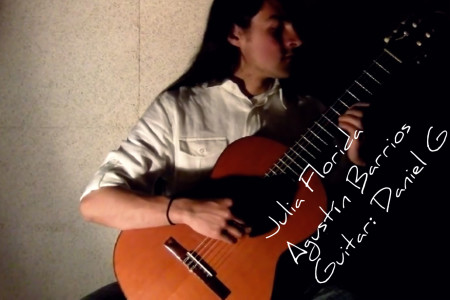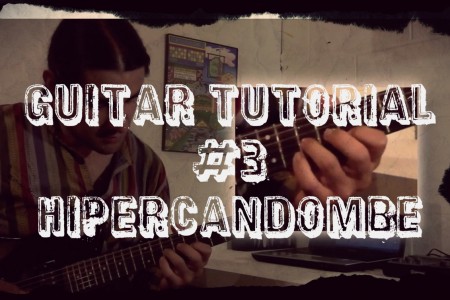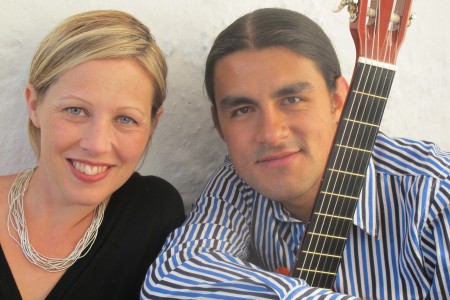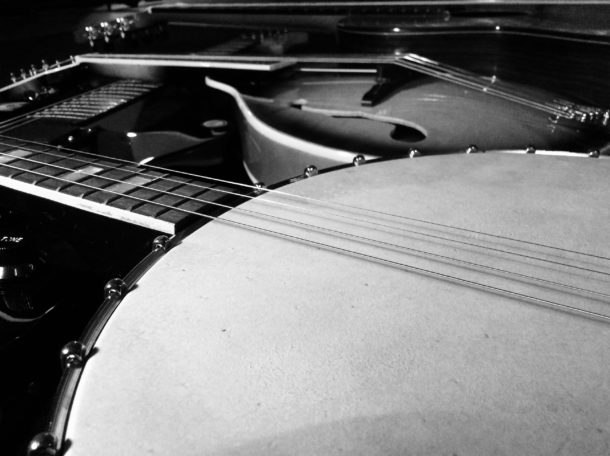Unlocking The Secrets Of The Guitar Fretboard… Or Any Fretted Instrument (part 2)
In part 1 of this series, we looked at the very basic concept of how to name the notes and how to utilize the layout of the piano keyboard to figure out flats and sharps. In part 2 we will be focusing on learning how to name the notes on the fretboard of the guitar. Welcome back. I hope you enjoy this article.
In part 1, by following the pattern of going up by 1/2 steps (minor seconds), to name the sharp keys , and down to name the flat keys, we ended with something looking like this:

We learned that the black keys of the piano can either be called sharps or flats. Deciding which kind of name to use depends on the scale or chord that is being used. We will talk more about this later in another article but for now, let’s jump right in to fretboards.
The Guitar
First things first:
- Most guitars have 6 strings. There are guitars with 7 or 8 strings which extends the lower register of the instrument. In this article we will focus on learning the notes on guitars with 6 strings.
- Most guitars will have 19 frets (the rectangles on the fretboard) and some will have either 22 or 24 frets. Having more frets gives the guitarist the ability to play higher notes, thus extending the upper range of the guitar.
Tuning:
There are several ways you can tune the strings of the guitar. Each tuning gives the guitar a different sound and different capabilities, depending on the sound or the style you are interested in. Most people will use the so called Standard Tuning and that is the tuning we will be using in this article.
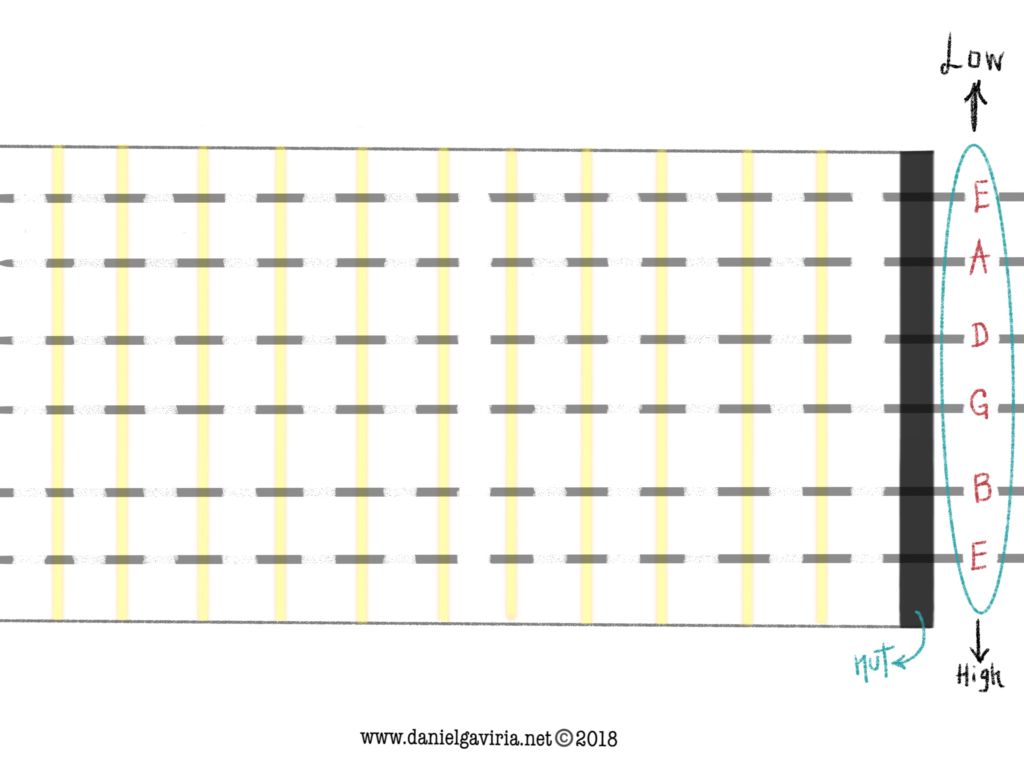
It is important to note that Standard Tuning is the tuning you get when you play the strings without placing any fingers on the fretboard. It is also very important to memorize the note name of each string in this tuning (or any tuning) in order to figure out the note name of each fret.
The way we name the notes on the fretboard is basically the same way we name the notes on the piano. On the guitar, every fret going up or down is also 1/2 step (minor second). This also means that we get a whole step (major second) every 2 frets, no matter where you start. Again, when going up from low to high we will use sharps. We will use flats going the opposite way, from high to low.
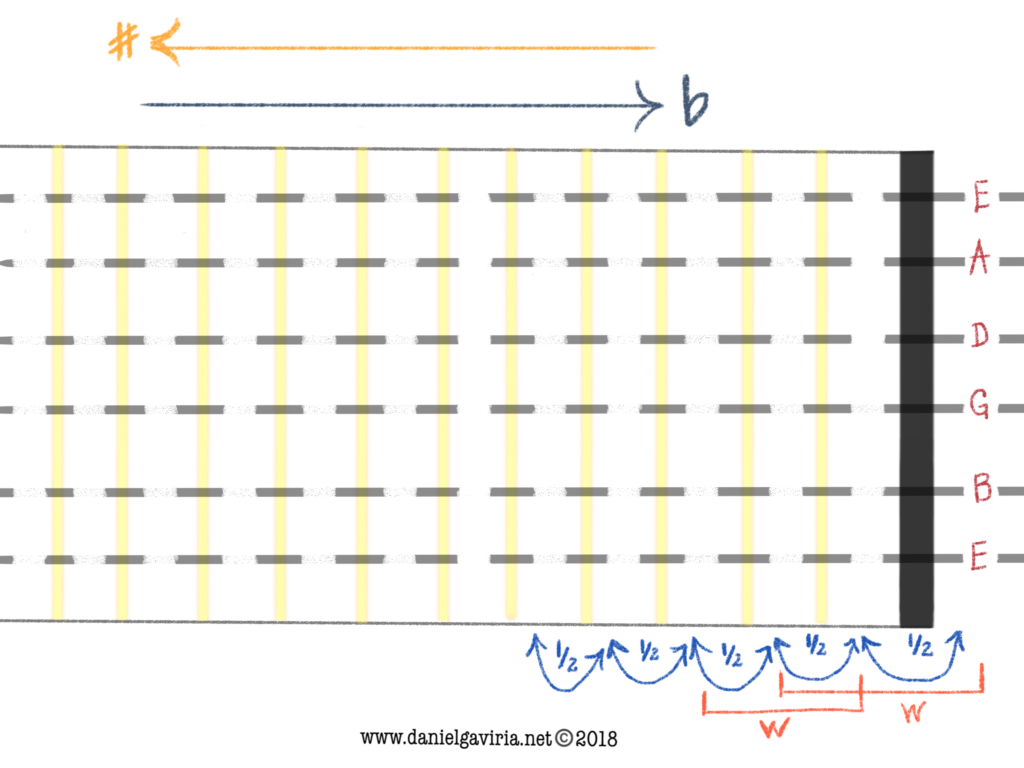
In Part 1 of the series, we started on the note C because that is the note the keyboard pattern of the piano starts on. On the guitar it works a little differently. We will start naming the notes depending on the tuning. In Standard Tuning, the first string played open (no fingers on the fretboard) is an E.We have to start counting our minor seconds from that note.
Finding the notes on the Guitar
Sharps
Let’s begin at our 1st open string, the high E. To figure out which note is played when we put a finger on the first fret, let’s look at our note calculator (see fig 1).
On the guitar when we play an open string followed by putting a finger on the first fret of the same string, we will always go a 1/2 step up. Therefore, on the high E string, when we press down on the first fret we will get an F, because there is a minor second between E and F (see fig 4).
Now we are on F (1st fret). From there on, what we need to do is to just go up by 1/2 steps (minor seconds) or fret by fret, looking at our note calculator (fig 1). Since we are going up, all the accidentals we play will be called sharps. If we move our finger a minor second up to the 2nd fret, the note we get is F# (F Sharp). On the 3rd fret we get a G, on the 4th fret we get a G#, on the 5ft fret an A, on the 6th fret an A#, and on the 7th fret a B. Our note calculator (fig 1) tells us that there is a 1/2 step between B and C. This means that on the guitar, the 8th fret is C. The 9th fret will be then C#, the 10th fret D, the 11th fret D# and the 12th fret E.
On the 12th fret we will always use the same note name as when we played the same string open (no fingers), just higher, and by that I mean an “octave” higher. An octave is the distance between two notes that are twelve half steps (12 minor seconds) apart either up or down.
To identify the notes on the 2nd string (B string) we will use the same method we used to name the notes on the E string. This time we start on the note B because that is the name of the 2nd string. Sorry if I am being repetitive I really want you to get this!
Look at the note calculator (fig 1). After B, comes C, which means that the first fret on the B string will be C. The 2nd fret will be C#, the 3rd fret D, the 4th fret D#, the 5th E, the 6th fret F, the 7th fret F#, the 8th fret G, the 9th fret G#, the 10th fret A, the 11th fret A# and finally our 12th fret B, making an octave (Fig 4.1).
The way we identify the notes on the other strings will be the same way we identified the notes on the E string (1st string) and the B string (2nd string). You just have to be aware of the name of the string when you play it “open” and start naming the notes of each fret using the note calculator. Try it yourself, you can check your “answers” later with the picture at the end of the article (fig 5).
Flats
Keep the note calculator at hand (fig. 1). To identify the Flats we need to go the opposite way (high to low), so we will start at the 12th fret on each string. I must remind you that on the guitar, a fret that can be a sharp note can also be a flat note. Sharp and the Flats share the same fret just like on the piano, where they share the same black key. The Guitar is an instrument that use EQUAL TEMPERAMENT (see Appendix on Part 1).
Take a look at figure 4.2. We already know that at the 12th fret on the E string we have an E. One fret down from the 12th fret (minor second or 1/2 step down) will take us to the 11th fret where we are going to find the note Eb. This means both Eb and D# are located on the 11th fret. Let’s keep going down, just naming the Flats. The 10th fret will always be D, the 9th fret Db (remember, we are going down), the 8th fret C, the 7th fret B, the 6th fret Bb, the 5th fret A, the 4th fret Ab, the 3rd fret G, the 2nd fret Gb and the 1st fret F. As you can see, the natural notes remain natural.
On the B string (second string) we will do just as we did on the 1st string, starting on the 12th fret named B. The 11th fret will then be Bb, the 10th fret will always be A, the 9th fret Ab, the 8th fret G, the 7th fret Gb, the 6th fret F, the 5th fret E, the 4th fret Eb, the 3rd fret D, the 2nd fret Db and the 1st fret C. And as we found on the 1st string, the natural notes remain natural and the Flats and the Sharps share the same fret.
With the remaining strings (G, D, A and low E), just follow the same procedure we followed to identify the flats on the E and B strings. Take this opportunity to name the notes on the other strings by yourself and compare your “answers” with the picture below (fig 5).
How did you do? Feel free to write me a message here, and let me know!
Now you may ask, what about the upper frets? The 13th, the 14th, etc…? If you keep going fret by fret by 1/2 steps, you will find that those upper frets will have the same exact names you identified on the first frets of each string. That is because you are, after the twelfth fret, one octave above. So at the 13th fret you will get a higher F than the F on the 1st fret of the E string. Remember, and octave is exactly twelve half steps up, just count the frets!
We are done!
On the guitar, this is basically the way we figure out all of the notes on the fretboard. The very good news is that this approach is also applicable to the Banjo (and it’s variations), the Mandolin (and all it’s variations), the Ukulele and any instrument in the world that has frets.You can even find the notes on the Violin, the Viola, the Cello and the Upright Bass using this approach (I have done it), although you have to have a very good ear to get the right pitch for the notes since these instruments don’t have frets. The names will change in some instruments that use different tuning, but essentially, they follow the same idea.
In the next article I will give you some ideas on how to memorize the notes on each fret. I will also show the notes on the guitar using other types of tunings, so stay “tuned”.
See you next time!
